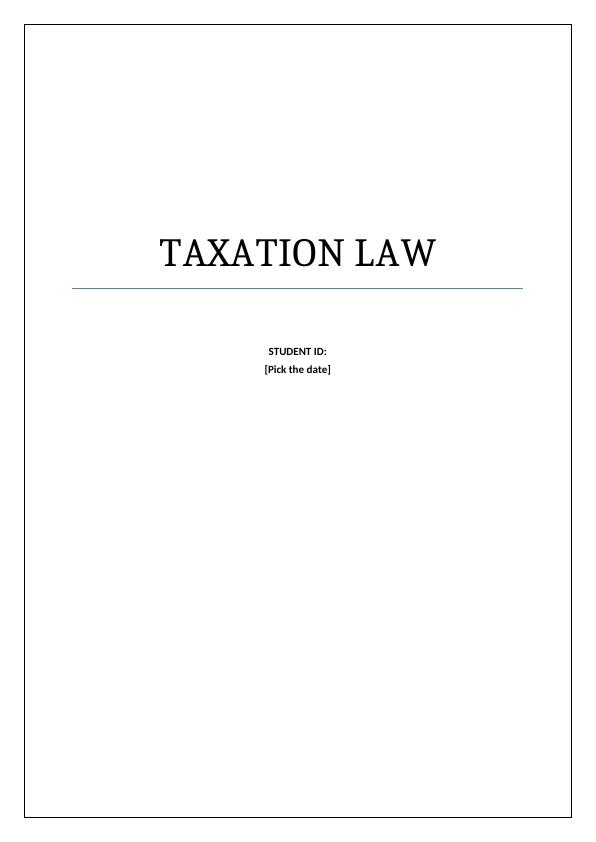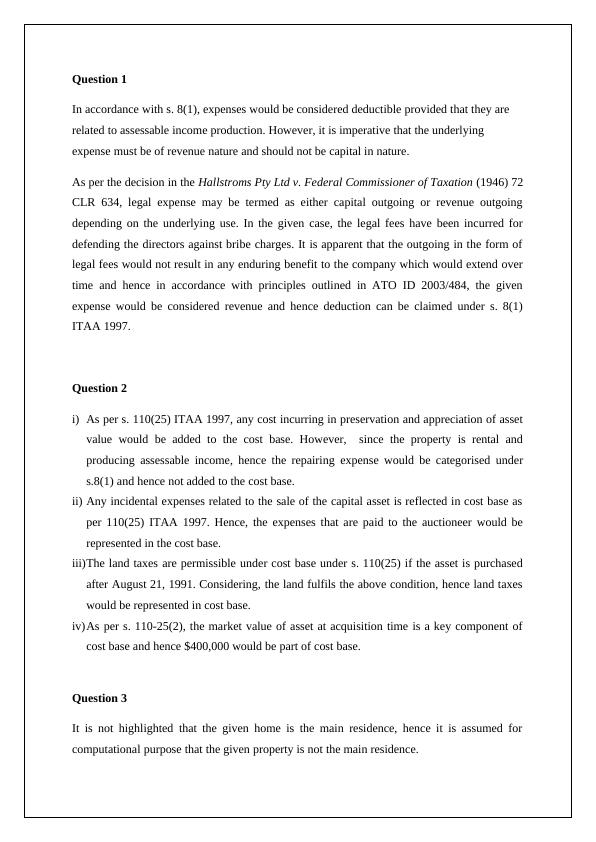Taxation laws : Sample Assignment
Added on 2021-05-31
6 Pages1637 Words46 Views
TAXATION LAWSTUDENT ID:[Pick the date]

Question 1In accordance with s. 8(1), expenses would be considered deductible provided that they are related to assessable income production. However, it is imperative that the underlying expense must be of revenue nature and should not be capital in nature. As per the decision in the Hallstroms Pty Ltd v. Federal Commissioner of Taxation(1946) 72CLR 634, legal expense may be termed as either capital outgoing or revenue outgoingdepending on the underlying use. In the given case, the legal fees have been incurred fordefending the directors against bribe charges. It is apparent that the outgoing in the form oflegal fees would not result in any enduring benefit to the company which would extend overtime and hence in accordance with principles outlined in ATO ID 2003/484, the givenexpense would be considered revenue and hence deduction can be claimed under s. 8(1)ITAA 1997.Question 2i)As per s. 110(25) ITAA 1997, any cost incurring in preservation and appreciation of assetvalue would be added to the cost base. However, since the property is rental andproducing assessable income, hence the repairing expense would be categorised unders.8(1) and hence not added to the cost base.ii)Any incidental expenses related to the sale of the capital asset is reflected in cost base asper 110(25) ITAA 1997. Hence, the expenses that are paid to the auctioneer would berepresented in the cost base.iii)The land taxes are permissible under cost base under s. 110(25) if the asset is purchasedafter August 21, 1991. Considering, the land fulfils the above condition, hence land taxeswould be represented in cost base.iv)As per s. 110-25(2), the market value of asset at acquisition time is a key component ofcost base and hence $400,000 would be part of cost base.Question 3It is not highlighted that the given home is the main residence, hence it is assumed forcomputational purpose that the given property is not the main residence.

The various additions to the cost base of the property as per s. 110-25 are highlighted below.Purchase price of house = $ 300,000Incidental costs related to buying = $ 10,000Preservation of title & wall dispute = $ 12,000Hence, total cost base of the house = 300000 + 10000 + 12000 = $ 322,000While considering the selling, it is essential to consider the market value of the propertywhich would include both house and boat. Hence, proceeds from sale = 600000 + 40000 = $640,000Thus, gross capital gains = 640,000 – 322,000 = $ 318,000Also, as per. S115(25), 50% discount on long term capital gains would be available.Hence, taxable capital gains = 0.5*318000 = $ 159,000Question 4With regards to depreciation, s.40-65 provides a choice to the taxpayer with regards to chooseeither the prime cost method or diminishing value method. Since the objective is to securemaximum depreciation, hence the diminishing value method would be preferred. Therelevant formula for this method is outlined in s. 40-72 as shown below.Hence, depreciation charged = 8000*(60/365) *(2/6)*0.9 = $394.52Adjustment has been made above considering that 90% use is business use and 10% ispersonal use. Depreciation would be charged only to the extent of business use. Question 5

End of preview
Want to access all the pages? Upload your documents or become a member.
Related Documents
Taxation Law Computation and Explanationslg...
|7
|1675
|204
Capital Gains Computation for Property Disposal under Taxation Lawlg...
|4
|711
|485
Business Laws - Sample Assignment PDFlg...
|8
|1393
|29
Taxation Law | Assignment-3lg...
|12
|2579
|19
Australian Taxation Law Case Studylg...
|8
|1855
|296
Taxation: Analysis of Tax Deductible Expenses and Net Capital Gains/Losseslg...
|6
|1444
|366
